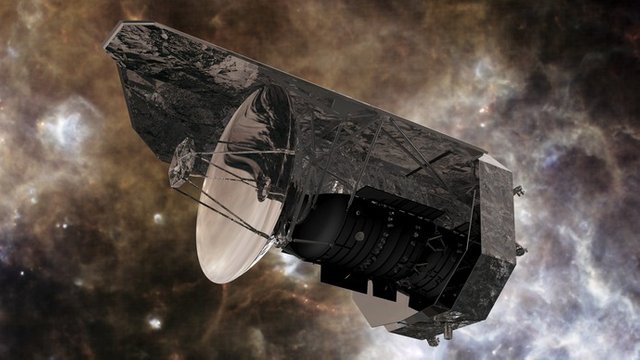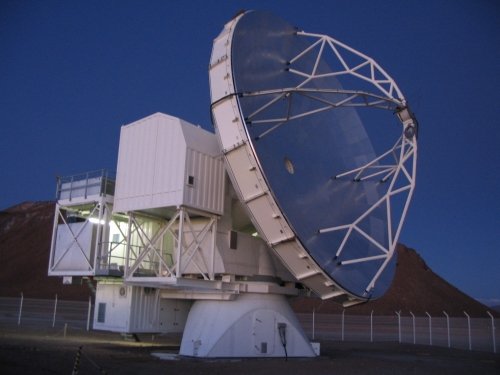Colliding Galaxies -- New Star Formation
Astronomers have caught two extremely bright and massive galaxies in the act of merging. As the galaxies collide astronomers are observing the an extreme example of star formation. The colliding galaxies are located in the Dorado constellation approximately 12.7 billion light years away. This gives astronomers a look back at a galaxy collision that occurred nearly 12.7 billion years ago, during the early universe.
Image Source
Astronomers speculate that the result of the merger may eventually form one of the most massive galaxy structures in the universe, a galaxy cluster.
Colliding Galaxies
The two galaxies are collectively called the ADFS-27 system where one galaxy is called "the horse" and the other called "the dragon".
Image Source
Based on data from the Hubble Space Telescope, here is a simulation of the Milky Way galaxy and the Andromeda galaxy colliding about 4 billion years from now.
1 minute video from VideoFromSpace published on 31 May 2012
The collision of galaxies initiates massive star formations.
5 minute video from The Universe Documentary published on 30 December 2014
European Space Agency's Herschel Space Observatory
Astronomers detected the two hyper-luminous starburst galaxies, ADFS-27 galaxy pair, using the European Space Agency's Herschel Space Observatory launched into space 14 May 2009.

Image Source
The Herschel Space Observatory is designed to detect radiation at far infrared and sub-millimeter wavelengths that uveils the face of the early universe.
Atacama Pathfinder EXperiment (APEX) Telescope
The APEX telescope located in northern Chile was used to confirm the initial observations of the ADFS-27 galaxy pair.

Image Source
The APEX telescope allows astronomers to observe and study cold dust and gas in distant galaxies, like the ADFS-27 galaxy pair. This telescope pave the way for further investigation and observations.
Atacama Large Millimeter/submillimeter Array (ALMA)
ALMA has an even higher resolution and sensitivity than APEX. The telescope array is located in Chile's Atacama desert.
Image Source
The telescope array revealed that ADFS-27 was in fact two distinct galaxies, precisely measured the distance to ADFS-27, and determined the two galaxies in ADFS-27 are about 30,000 light year apart. The ALMA observations indicate that the system has about 50 times the star forming gas the our Milk Way galaxy. And the star formation is occuring about 1,000 times faster than in our Milky Way galaxy.
Eight Facts About ALMA
The radio telescope array combines the forces of 66 radio antennas, most almost 40 feet (12 meters) in diameter, to create images comparable to those that could be obtained with a single 46,000-foot-wide (14,000 meters) dish. The observatory is accurate enough to discern an object the size of a golf ball from 9 miles (15 kilometers) away.
The telescope is a collaboration of four continents, being sponsored by countries in North America, East Asia, and Europe, in cooperation of Chile. Planning and constructing the observatory took thousands of scientists and engineers from around the world more than decade to build.
The ALMA observatory is among the highest instruments on Earth, at an altitude of 16,570 feet (5,050 meters) above sea level. Its perch high atop the Chajnantor plateau puts it above much of the blurs and distortions of light by the Earth's atmosphere.
The ALMA observatory's location in Chile's Atacama desert, the driest place in the world, give observers nights that are clear of clouds and free of light-distorting moisture. Some weather stations in the desert have never received precipitation, and scientists think the Atacama got no significant rainfall between 1570 and 1971.
The surfaces of ALMA's dozens of radio dishes are almost perfect, with none deviating from an exact parabola by more than 20 micrometers. This prevents any incoming radio waves from being lost, so that the resulting picture captures as much distant cosmic light as possible. The each radio dish, which weighes about 100 tons, is made of ultra-stable Carbon Fiber Reinforced Plastic (CFRP) for the reflector base, with reflecting panels of rhodium-coated nickel.
To prevent introducing noise to the signal, the electronic detector called the "front end" that amplifies and converts the radio signals collected at each antenna must be kept at a chilling 4 Kelvin (minus 452 degrees Fahrenheit, or minus 269 degrees Celsius).
The ALMA observatory cost $1.3 billion to construct, with the price tag being split by the three sponsoring regions: North America, East Asia, and Europe. Of the total cost, about $500 million was contributed by U.S. taxpayers.
ALMA looks at the skies in millimeter and submillimeter wavelengths (submillimeter light has slightly shorter wavelengths than millimeter light). These ranges fall along the boundary between the radio and microwave bands of the electromagnetic spectrum, and have longer wavelengths than optical light. This band of the electromagnetic spectrum allows astronomers to probe into the dark cores of gas clouds to study star and planet formation, and to see extremely distant light that's been shifted toward the red end of the spectrum.
Many More Observations to Come
Astronomers estimate that the ADFS-27 galaxies collisions will take a few hundred million years to form one massive, elliptical galaxy.
Sources and Full Articles
Duo of titanic galaxies caught in extreme starbursting merger, Imperial College London, 13 November 2017
Atacama Pathfinder EXperiment (APEX)
ALMA Telescope Cool Facts, SPACE.com, 8 March 2013
Rise of the Titans: A Dusty, Hyper-luminous "870 μm Riser" Galaxy at z ~ 6, The Astrophysical Journal, 13 November 2017
Thank You!
Thank you!
When super massive black holes surrounded by stars collide :)
nice topics. I like there galaxy, astronomy and Study of universe type of topics. Thanks for sharing them.
My Screensavers programm is Galaxis on Linux, it shows some galaxis moving and crashing into each other :)
ohhh galaxiesss
hot post
Nice post...
Good information sir.thanks
Hi @etcmike. It's so interesting for me to be aware of all the activities that are happening outside the planet earth. When I stop and think about it, then I recognize once again how minuscules we are in the galaxy...sublime...
Completely agree! It is a vast universe, full of possibilities. The new discoveries happening everyday just go to show us how much we have to learn.
Have a wonderful week!
Steem on,
Mike
That is a very great discoveries and it is a very great experience to watch all these videos.
like your post